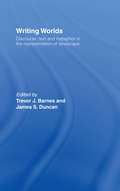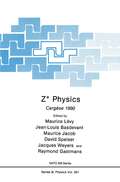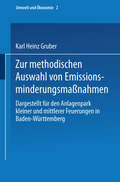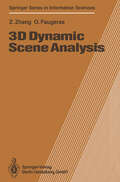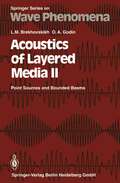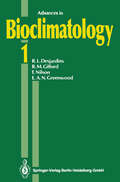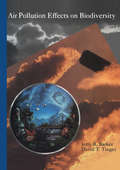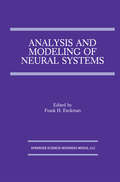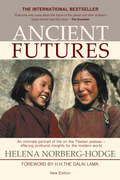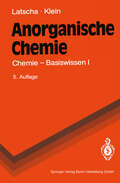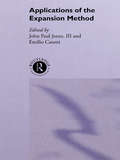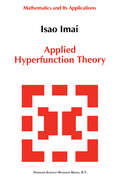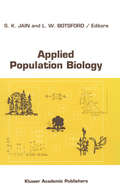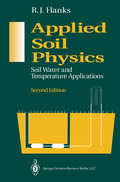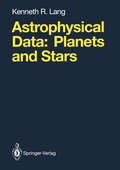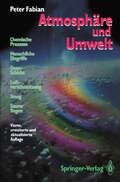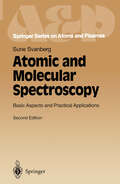- Table View
- List View
Writing Worlds: Discourse, Text and Metaphor in the Representation of Landscape
by Trevor J. Barnes James S. DuncanWriting Worlds represents the first systematic attempt to apply poststructuralist ideas to landscape representation. Landscape - city, countryside and wilderness - is explored through the discourse of economics, geopolitics and urban planning, travellers descriptions, propaganda maps, cartography and geometry, poetry and painting. The book aims to deconstruct geographical representation in order to explore the dynamics of power in the way we see the world.
Z° Physics: Cargèse 1990 (Nato Science Series B: #261)
by Maurice Lévy Jean-Louis Basdevant Maurice Jacob David Speiser Jacques Weyers Raymond GastmansProceedings of a NATO ASI held in Cargese, France, August 13--25, 1990
Zur methodischen Auswahl von Emissionsminderungsmaßnahmen: Dargestellt für den Anlagenpark kleiner und mittlerer Feuerungen in Baden-Württemberg (Umwelt und Ökonomie #2)
by Karl H. GruberMit der Umsetzung des Umweltprogramms der Bundesregierung begannen bedeutende Aktivitäten auf den Gebieten Forschung und Entwicklung von Umweltschutzmaßnahmen. Zu Beginn standen vor allem Fragen der Luft reinhaltung im Vordergrund. Fragen zum Verbleib der aus diesen Anlagen resultierenden festen und flüssigen Reststoffe rückten erst in letzter Zeit in den Mittelpunkt des Interesses. Für kleine und mittlere Feuerungsanlagen mit fossilen Brennstoffen treten Emissionsbegrenzungen aufgrund von Fristen überwiegend erst im Frühjahr 1994 in Kraft. Die Durchführung von Minderungsmaßnahmen ist dabei durch neue gesetzliche Vorgaben ausnahmslos an ökologisch günstige Lösungen der Reststoffentsorgungsproblematik gebunden. Ziel der vorliegenden Arbeit war die Entwicklung von Strategien, die es ermöglichen, für kleine und mittlere Feuerungsanlagen technisch-ökologisch geeignete, langfristig sichere und darüber hinaus wirtschaftliche Minderungs alternativen herauszufinden. Neben der Konzeption und Bewertung rele vanter Emissionsminderungsmaßnahmen und Reststoffentsorgungsoptionen erfolgte erstmals die Generierung einer operationalisierten entscheidungs unterstützenden Methode für die Auswahl von Luftreinhaltemaßnahmen. Die praktische Umsetzung der Methode wurde am Beispiel der TA Luft Feuerungen von Baden-Württemberg vorgenommen. Aufgebaut wurde auf einem umfangreichen Forschungsprojekt, das im Auf trag des Umweltministeriums Baden-Württemberg am Institut für Industrie betriebslehre und Industrielle Produktion der Universität Karlsruhe (TH) in den Jahren 1987 bis 1990 durchgeführt wurde.
3D Dynamic Scene Analysis: A Stereo Based Approach (Springer Series in Information Sciences #27)
by Zhengyou Zhang Olivier Faugerashe problem of analyzing sequences of images to extract three-dimensional T motion and structure has been at the heart of the research in computer vi sion for many years. It is very important since its success or failure will determine whether or not vision can be used as a sensory process in reactive systems. The considerable research interest in this field has been motivated at least by the following two points: 1. The redundancy of information contained in time-varying images can over come several difficulties encountered in interpreting a single image. 2. There are a lot of important applications including automatic vehicle driv ing, traffic control, aerial surveillance, medical inspection and global model construction. However, there are many new problems which should be solved: how to effi ciently process the abundant information contained in time-varying images, how to model the change between images, how to model the uncertainty inherently associated with the imaging system and how to solve inverse problems which are generally ill-posed. There are of course many possibilities for attacking these problems and many more remain to be explored. We discuss a few of them in this book based on work carried out during the last five years in the Computer Vision and Robotics Group at INRIA (Institut National de Recherche en Informatique et en Automatique).
Acoustics of Layered Media II: Point Sources and Bounded Beams (Springer Series on Wave Phenomena #10)
by Leonid M. Brekhovskikh Oleg A. GodinThis is the sequel to our book Acoustics of Layered Media I: Plane and Quasi Plane Waves (Springer Ser. Wave Phenom. , Vol. 5). Taken together, these two monographs present a systematic exposition of the theory of sound propagation in inhomogeneous media, which starts from first principles and includes recent results. More advanced topics are considered in this second volume. Although the theory of wave beams and fields of localized sources is more sophisticated than the theory of quasi-plane waves, it embraces a much wider range of interesting problems that are also important for applications. We exploit the results of Acoustics of Layered Media I, as long as it is expedient to consider sound fields as a superposition of plane or quasi-plane waves. However, the knowledgeable reader will view this book as self-contained. Similar topics have been treated in the book by L. M. Brekhovskikh, Waves in Layered Media, the English version of the second edition of which was published by Academic Press in 1980. Since Waves in Layered Media became very popular, we have tried here to retain its spirit. However, the majority of this text is devoted to new material which reflects the significant progress of the theory during recent years. In particular, acoustic fields in a moving fluid are considered and much attention is paid to sound propagation in range dependent environments, which is currently on the leading edge of research activities.
Advances in Bioclimatology 1 (Advances in Bioclimatology #1)
by R.L. Desjardins R.M. Gifford T. Nilson E.A.N. GreenwoodAtmospheric carbon dioxide concentration has increased globally from about 280 ppm before the Industrial Revolution (Pearman 1988) to about 353 ppm in 1990. That increase, and the continuing increase at a rate of about 1.5 ppm per annum, owing mainly to fossil fuel burning, is likely to cause change in climate, in primary productivity of terrestrial vegetation (managed and unmanaged), and in the degree of net sequestration of atmospheric CO into organic form. The quantitative role 2 of the latter in attenuating the increase in atmospheric CO concentration itself is 2 an important but uncertain element of the global carbon-cycle models that are required to predict future increases of atmospheric CO concentration. 2 In my experience in workshops and other multidisciplinary gatherings, argument arises in discussion of this topic among different groups of scientists such as bioclimatologists, plant physiologists, biogeochemists and ecologists. Plant concentration physiologists are often impressed by the positive effect of higher CO 2 on plant growth under experimental controlled environments and argue that this would be at least partly expressed in the field for many species and communities.
Advances in Scientific Visualization (Focus on Computer Graphics)
by Frits H. Post Andrea J. S. HinScientific visualization is a new and rapidly growing area in which efforts from computer graphics research and many scientific and engineering disciplines are integrated. Its aim is to enhance interpretation and understanding by scientists of large amounts of data from measurements or complex computer simulations, using computer generated images and animation sequences. It exploits the power of human visual perception to identify trends and structures, and recognize shapes and patterns. Development of new numerical simulation methods in many areas increasingly depends on visualization as an effective way to obtain an intuitive understanding of a problem. This book contains a selection of papers presented at the second Eurographics workshop on Visualization in Scientific Computing, held in Delft, the Netherlands, in April 1991. Theissues addressed are visualization tool and system design, new presentation techniques for volume data and vector fields, and numerous case studies in scientific visualization. Application areas include geology, medicine, fluid dynamics, molecular science, and environmental protection. The book will interest researchers and students in computer graphics and scientists from many disciplines interested in recent results in visual data analysis and presentation. It reflects the state of the art in visualization research and shows a wide variety of experimental systems and imaginative applications.
Air Pollution Effects on Biodiversity
by David T. Tingey Jerry R. BarkerBiodiversity is the delicate ecological balance within biological systems such as species and populations. Evidence suggests air pollution disrupts and impoverishes ecosysytems processes, and genetic and population diversity. Based on a symposium conducted by the EPA's Environmental Research Laboratory, this book pulls together current knowledge on the subject, assesses its relevance, and offers a framework for future research on the impact of air pollution on biodiversity through all levels of biological organization. This text is particularly timely due to acid rain and other toxic problems. The text also discusses the best available control technology, management practices, alternative chemicals, and legislative ways to reduce the impact of air pollution on biodiversity.
Ancient Futures: Lessons From Ladakh For A Globalizing World (3rd edition)
by Helena Norberg-Hodge H.H. The Dalai LamaA moving portrait of tradition and change in Ladakh, or “Little Tibet,” Ancient Futures is also a scathing critique of the global economy and a rallying call for economic localization. When Helena Norberg-Hodge first visited Ladakh in 1975, she found a pristine environment, a self-reliant economy and a people who exhibited a remarkable joie de vivre. But then came a tidal wave of economic growth and development. Over the last four decades, this remote Himalayan land has been transformed by outside markets and Western notions of “progress.” As a direct result, a whole range of problems—from polluted air and water to unemployment, religious conflict, eating disorders and youth suicide—have appeared for the first time. Yet this is far from a story of despair. Social and environmental breakdown, Norberg-Hodge argues, are neither inevitable nor evolutionary, but the products of political and economic decisions—and those decisions can be changed. In a new Preface, she presents a kaleidoscope of projects around the world that are pointing the way for both human and ecological well-being. These initiatives are the manifestation of a rapidly growing localization movement, which works to rebuild place-based cultures—strengthening community and our connection with nature. Ancient Futures challenges us to redefine what a healthy economy means, and to find ways to carry centuries-old wisdom into our future. The book and a related film by the same title have, between them, been translated into more than 40 languages.
Anorganische Chemie: Chemie — Basiswissen I (Springer-Lehrbuch)
by Hans P. Latscha Helmut A. KleinChemie-Basiswissen stellt in drei Bänden den gesamten Wissensstoff für das Diplom-Chemiker-Vorexamen dar. Studenten mit Chemie als Nebenfach finden in den drei Bänden abgerundete Darstellungen der Anorganischen Chemie, der Organischen Chemie und der Analytischen Chemie mit einer Einführung in die Allgemeine Chemie. Das didaktische Konzept der Autoren und die Stoffauswahl haben Chemie-Basiswissen zu einem beliebten und erfolgreichen Lehrbuch gemacht.
Anyons: Quantum Mechanics of Particles with Fractional Statistics (Lecture Notes in Physics Monographs #14)
by Alberto LerdaParticles with fractional statistics interpolating between bosons and fermions have attracted considerable interest from mathematical physicists. In recent years it has emerged that these so-called anyons have rather unexpected applications, such as the fractional Hall effect, anyonic excitations in films of liquid helium, and high-temrperature superconductivity. Furthermore, they are discussed also in the context of conformal field theories. This book is a systematic and pedagogical introduction that considers the subject of anyons from many different points of view. In particular, the author presents the relation of anyons to braid groups and Chern-Simons field theory and devotes three chapters to physical applications. The book, while being of interest to researchers, primarily addresses advanced students of mathematics and physics.
Applications of the Expansion Method
by Emilio Casetti John-Paul Jones IIIFirst published in 2004. Routledge is an imprint of Taylor & Francis, an informa company.
Applications of the Expansion Method
by John Paul JonesFirst published in 2004. Routledge is an imprint of Taylor & Francis, an informa company.
Applied Hyperfunction Theory (Mathematics and its Applications #8)
by Isao ImaiGeneralized functions are now widely recognized as important mathematical tools for engineers and physicists. But they are considered to be inaccessible for non-specialists. To remedy this situation, this book gives an intelligible exposition of generalized functions based on Sato's hyperfunction, which is essentially the `boundary value of analytic functions'. An intuitive image -- hyperfunction = vortex layer -- is adopted, and only an elementary knowledge of complex function theory is assumed. The treatment is entirely self-contained. The first part of the book gives a detailed account of fundamental operations such as the four arithmetical operations applicable to hyperfunctions, namely differentiation, integration, and convolution, as well as Fourier transform. Fourier series are seen to be nothing but periodic hyperfunctions. In the second part, based on the general theory, the Hilbert transform and Poisson-Schwarz integral formula are treated and their application to integral equations is studied. A great number of formulas obtained in the course of treatment are summarized as tables in the appendix. In particular, those concerning convolution, the Hilbert transform and Fourier transform contain much new material. For mathematicians, mathematical physicists and engineers whose work involves generalized functions.
Applied Population Biology (Monographiae Biologicae #67)
by S. K. Jain L. W. BotsfordAn increasing variety of biological problems involving resource management, conservation and environmental quality have been dealt with using the principles of population biology (defined to include population dynamics, genetics and certain aspects of community ecology). There appears to be a mixed record of successes and failures and almost no critical synthesis or reviews that have attempted to discuss the reasons and ways in which population biology, with its remarkable theoretical as well as experimental advances, could find more useful application in agriculture, forestry, fishery, medicine and resource and environmental management. This book provides examples of state-of-the-art applications by a distinguished group of researchers in several fields. The diversity of topics richly illustrates the scientific and economic breadth of their discussions as well as epistemological and comparative analyses by the authors and editors. Several principles and common themes are emphasized and both strengths and potential sources of uncertainty in applications are discussed. This volume will hopefully stimulate new interdisciplinary avenues of problem-solving research.
Applied Soil Physics: Soil Water and Temperature Applications (Advanced Series in Agricultural Sciences #8)
by R.J. HanksThis second edition was undertaken to update information which has become available since the first edition and to convert completely to the SI system. The main objective of this book is to stress application of soil physics principles to real problems. The problems are heavily oriented toward the soil water-plant-atmosphere continuum. This book grew out of a course taught to upper level undergraduate and graduate students from many different disciplines and backgrounds. I have found that problems are a very good teaching tool because students need to solve them on their own and adapt them to their own understanding. I have found this problem-solving experience to be greatly enhanced if examples are available. Thus, this book is heavily laden with examples. This edition includes reference to many models, involving basic concepts discussed herein, by which it is possible to solve many more realistic--and more complex--problems such as drainage below the root zone (and associated pollution), plant growth as related to climate, soil properties, management, etc. The intent is to encourage students to advance to the next level. The book is not intended to be a complete introduction to applied soil physics, but rather to emphasize problem-solving and the important aspects of soil water and temperature.
Astrophysical Data: Planets and Stars
by Kenneth R. LangThis volume of Astrophysical Data deals with Planets and Stars; a second volume, Part II, will give data for Galaxies and the Universe. They both pro vide basic data for use by all scientists, from the amateur astronomer to the professional astrophysicist. In this first volume, we not only provide physical parameters of planets, stars and their environment, but we also provide the celestial coordinates required to observe them. Here we use c.g.s. units, for they are the most commonly used in astron omy and astrophysics; but our volume begins with astronomical and physical constants and the conversion factors needed for other units. The next section concerns the planets and their satellites; it singles out the Earth and Moon for special treatment. Spacecraft rendezvous with the planets and satellites have led to improved values for their atmospheric compositions, orbital parameters, magnetic fields, masses, radii, rotation periods, and surface pressures and temperatures. This section also contains data for the asteroids, comets and their debris. We then discuss everyday stars, beginning with the Sun, and continuing with basic stellar data, the brightest stars and nearby stars. Special categories of stars, such as the Wolf-Rayet stars, magnetic stars, flare stars, and RS CVn binary stars, are included.
Atmosphäre und Umwelt: Chemische Prozesse · Menschliche Eingriffe · Ozon-Schicht · Luftverschmutzung · Smog · Saurer Regen
by Peter FabianEin allgemeinverständlicher Überblick über die Vorgänge in der Athmosphäre und die Auswirkungen menschlicher Eingriffe auf das Ökosystem Erde.
Atmospheric Deposition and Forest Nutrient Cycling: A Synthesis of the Integrated Forest Study (Ecological Studies #91)
by Dale W. Johnson Steven E. LindbergOver the past decade there has been considerable interest in the effects of atmospheric deposition on forest ecosystems. This volume summarizes the results of the Integrated Forest Study (IFS), one of the most comprehensive research programs conducted. It involved intensive measurements of deposition and nutrient cycling at seventeen diverse forested sites in the United States, Canada, and Norway. The IFS is unique as an applied research project in its complete, ecosystem-level evaluation of nutrient budgets, including significant inputs, outputs, and internal fluxes. It is also noteworthy as a more basic investigation of ecosystem nutrient cycling because of its incorporation of state-of-the-art methods, such as quantifying dry and cloud water deposition. Most significantly, the IFS data was used to test several general hypotheses regarding atmospheric deposition and its effects. The data sets also allow for far-reaching conclusions because all sites were monitored over the same period using comparable instruments and standardized protocols.
Atomic and Molecular Spectroscopy: Basic Aspects and Practical Applications (Springer Series on Atomic, Optical, and Plasma Physics #6)
by Sune SvanbergA wide-ranging review of modern techniques in atomic and molecular spectroscopy. A brief description of atomic and molecular structure is followed by the relevant energy structure expressions. A discussion of radiative properties and the origin of spectra leads into coverage of X-ray and photoelectron spectroscopy, optical spectroscopy, and radiofrequency and microwave techniques. The treatment of laser spectroscopy investigates various tunable sources and a wide range of techniques characterized by high sensitivity and high resolution. Throughout this book, the relation between fundamental and applied aspects is shown, in particular by descriptions of applications to chemical analysis, photochemistry, surface characterisation, environmental and medical diagnostics, remote sensing and astrophysics.
Automated Pattern Analysis in Petroleum Exploration
by Sailes K. Sengupta IbrahimPalazHere is a state-of-the-art survey of artificial intelligence in modern exploration programs. Focussing on standard exploration procedures, the contributions examine the advantages and pitfalls of using these new techniques, and, in the process, provide new, more accurate and consistent methods for solving old problems. They show how expert systems can provide the integration of information that is essential in the petroleum industry when solving the complicated questions facing the modern petroleum geoscientist.
Basement Tectonics 7: Proceedings of the Seventh International Conference on Basement Tectonics, held in Kingston, Ontario, Canada, August 1987 (Proceedings of the International Conferences on Basement Tectonics #1)
by John M. SiliskiProceedings of the Seventh International Conference on Basement Tectonics, held in Kingston, Ontario, Canada, August 1987
Basement Tectonics 8: Characterization and Comparison of Ancient and Mesozoic Continental Margins (Proceedings of the International Conferences on Basement Tectonics #2)
by Mervin J. Bartholomew Donald W. Hyndman David W. Mogk Robert MasonThe 8th International Conference on Basement Tectonics was held in Butte, Montana, August 8-12,1988. Historically, basement tectonics conferences have focused on such topics as reactivation of faults, the influence of basement faults on metallogeny and hyrocarbon accumulation, and the use of geophysical and remote sensing techniques to interpret subsurface and surface geology. The 8th Conference diverged from past conferences in that a unifying theme was selected. Because ancient major terrane or cratonic boundaries are often postulated to be fault zones which are subsequently reactivated, the conference was organized to examine all aspects of ancient continental margins and terrane boundaries and to compare younger (Mesozoic) ones, about which more is known, with older (Paleozoic and Precambrian) ones. Moreover, because the 8th Conference was held in the northwestern United States, a greater emphasis was placed on the Mesozoic margin of western North America and the North American shield. The seven oral sessions and four poster sessions all dealt with aspects of the conference theme: characterization and comparison of ancient continental margins. The organizers extend their thanks to those individuals who graciously consented to serve as moderators for the oral sessions: John M. Bartley, Mark S. Gettings, M. Charles Gilbert, John M. Guilbert, Donald W. Hyndman, William P. Leeman, Robert Mason, and A. Krishna Sinha. The program with abstracts volume was prepared by S. E. Lewis and M. J. Bartholomew.
Basement Tectonics 9: Australia and Other Regions Proceedings of the Ninth International Conference on Basement Tectonics, held in Canberra, Australia, July 1990 (Proceedings of the International Conferences on Basement Tectonics #3)
by M. J. Rickard H. J. Harrington P. R. WilliamsThe Ninth International Conference on Basement Tectonics was held at the Australian National University in Canberra 2-6 July 1990. The opening keynote address was given by Prof. R.W.R. Rutland, Director of the Bureau of Mineral Resources. Other keynote speakers were E.S.T. O'Driscoll, an Australian consultant, and Prof P. Bankwitz, Central Institute for Physics of the Earth, Potsdam, GDR. Technical sessions were arranged by session conveners on the following five topic- i) The structure of the Australian craton and cover basins; ii) Basement structure of continental regions; iii) Structural patterns and mineral deposits; iv) Techniques for analysing basement structures; v) Structural patterns in oceanic crust. The arrangement of papers for this Proceedings Volume has been simplified. Part 1 deals with Australia, Part 2 with other areas and Part 3 lists the titles of all the papers read at the conference. Abstracts of these papers are available in Geological Society of Australia Abstracts No 26 and may be purchased for $AI0 from the Geological Society of Australia Office, ANA House, 301 George Street, Sydney NSW 2000. Field trips to view aspects of the Lachlan Fold Belt and the Sydney Basin were assisted by H.J. Harrington, D. Branagan, D. Wyborn, B. Drummond and M.J. Rick~d. A longer field trip, aborted through low enrolments, was organized by H.J. Harrington with assistance from W. Preiss, N. Cook, R. Glenn, A. Grady, and P. James; this assistance is gratefully acknowledged.
